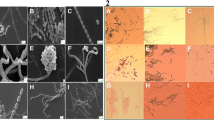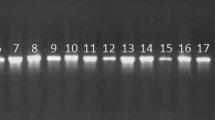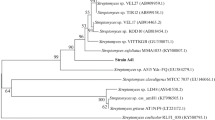Abstract
Saline environments are largely unexplored sources of actinomycetes with the potential to produce biologically active secondary metabolites. A total of 34 actinomycete isolates from water, sediments and mostly rhizosphere (82%) were collected from different sites at Howz Soltan Lake in Iran. Based on phylogenetic analysis, the isolates belonged to the genera Streptomyces, Nocardia and Saccharomonospora. Cytotoxic assay revealed extract from isolate act9 as the most potent (19.716±5.72 µg/ml) against the MDA-MB-231 human breast cancer cell. Also, 38% of the isolates showed antimicrobial activity against some of the test microorganisms. The ethyl-acetate extract of isolate act18 showed the strongest antibacterial effect against Staphylococcus aureus and MRSA, and was further analyzed by GC/MS. Ar-tumerone (26.41%) and butyl isodecyl phthalate (21.77 %) were the main constituents detected in the extract. This is the first time Ar-tumerone is being detected in a prokaryote. Isolate act18 showed a high 16S rRNA sequence similarity to that of Streptomyces youssoufiensis DSM 41920. In addition, a number of the isolates produced different enzymes including lipase, amylase, protease, gelatinase, urease and lecithinase. Some of the isolates belonging to the genera Streptomyces and Nocardia exhibited plant growth promoting activity such as increased seed germination, stem length and the number of Echium leaves during the 20 days. Findings from this study indicated the diversity and biosynthetic potential of actinomycetes from saline environment.







Similar content being viewed by others
Data availability
The datasets generated during the current study are available from the corresponding author on a reasonable request.
References
Abdelshafy Mohamad OA, Li L, Ma JB et al (2018) Halophilic Actinobacteria biological activity and potential applications. In: Extremophiles in Eurasian ecosystems: ecology, diversity, and applications Springer, Singapore
Balseiro-Romero M, Gkorezis P, Kidd PS, Van Hamme J, Weyens N, Monterroso C, Vangronsveld J (2017) Use of plant growth promoting bacterial strains to improve Cytisus striatus and Lupinus luteus development for potential application in phytoremediation. Sci Total Environ 581:676–88. https://doi.org/10.1016/j.scitotenv.2016.12.180
Benson JH (2002) Microbiological Applications. Laboratory manual in general Microbiololy. 8th edition.
Bloemberg GV, Lugtenberg BJ (2001) Molecular basis of plant growth promotion and biocontrol by rhizobacteria. Curr Opin Plant Biol 4(4):343–350. https://doi.org/10.1016/S1369-5266(00)00183-7
Bundale S, Pathak A (2022) Anti-quorum sensing compounds from rare actinobacteria. in actinobacteria-diversity, applications and medical aspects. IntechOpen.
Chanthasena P, Nantapong N (2016) Biodiversity of antimicrobial-producing actinomycetes strains isolated from dry dipterocarp forest soil in northeast Thailand. Braz Arch Biol Techn. https://doi.org/10.1590/1678-4324-2016150674
Chen YG, Wang YX, Zhang YQ, Tang SK, Liu ZX, Xiao HD, Xu LH, Cui XL, Li WJ (2009) Nocardiopsis litoralis sp. nov., a halophilic marine actinomycete isolated from a sea anemone. Int J Syst Evol Microbiol 59(11):2708–2713
Chouyia FE, Romano I, Fechtali T et al (2020) P-Solubilizing Streptomyces roseocinereus MS1B15 with multiple plant growth-promoting traits enhance barley development and regulate rhizosphere microbial population. Front Plant Sci 11:1137
Du Y, Wang T, Jiang J et al (2022) Biological control and plant growth promotion properties of Streptomyces albidoflavus St-220 isolated from Salvia miltiorrhiza rhizosphere. Front plant sci 13:976813–976813
Elshafie HS, Camele I (2022) Rhizospheric Actinomycetes revealed antifungal and plant-growth-promoting activities under controlled environment. Plants 11(14):1872. https://doi.org/10.3390/plants11141872
Ezeobiora CE, Igbokwe NH, Amin DH et al (2022) Uncovering the biodiversity and biosynthetic potentials of rare actinomycetes. Future J Pharm Sci 8(1):1–19
Farda B, Djebaili R, Vaccarelli I, Del Gallo M, Pellegrini M (2022) Actinomycetes from caves: an overview of their diversity, biotechnological properties, and insights for their use in soil environments. Microorganisms 10(2):453
Ferreira LA, Henriques O, Andreoni AA, Vital GR, Campos MM, Habermehl GG, de Moraes VL (1992) Antivenom and biological effects of ar-turmerone isolated from Curcuma longa (Zingiberaceae). Toxicon 30(10):1211–1218
Gozari M, Zaheri A, Jahromi ST, Gozari M, Karimzadeh R (2019) Screening and characterization of marine actinomycetes from the northern Oman Sea sediments for cytotoxic and antimicrobial activity. Int Microbio 22(4):521–530. https://doi.org/10.1007/s10123-019-00083-3
He D, Li X, Sai X, Wang L, Li S, Xu Y (2018) Camellia nitidissima CW Chi: a review of botany, chemistry, and pharmacology. Phytochem Rev 17(2):327–349
Hong K, Gao AH, Xie QY, Gao HG, Zhuang L, Lin HP, Yu HP, Li J, Yao XS, Goodfellow M, Ruan JS (2009) Actinomycetes for marine drug discovery isolated from mangrove soils and plants in China. Mar drug 7(1):24–44. https://doi.org/10.3390/md7010024
Houssam MA (2009) An antifungal agent produced by Streptomyces olivaceiscleroticus AZ-SH514. World App Sci J 6:1495–1505
Jayashree S, Vyas V, Bhatnagar GP, Syed S (1991) On selection of methods and media for isolation of freshwater actinomycetes. Env techn 12(12):1183–1186. https://doi.org/10.1080/09593339109385119
Joycharat N, Thammavong S, Voravuthikunchai SP, Plodpai P, Mitsuwan W, Limsuwan S, Subhadhirasakul S (2014) Chemical constituents and antimicrobial properties of the essential oil and ethanol extract from the stem of Aglaia odorata Lour., Natural Product Research 2823, 2169–2172.
Kruasuwan W, Thamchaipenet A (2016) Diversity of culturable plant growth-promoting bacterial endophytes associated with sugarcane roots and their effect of growth by co-inoculation of diazotrophs and actinomycetes. J Plant Growth Regul 35(4):1074–1087. https://doi.org/10.1007/s00344-016-9604-3
Kumar RR, Jadeja VJ (2016) Isolation of actinomycetes: a complete approach. Int J Curr Microbiol App Sci 5(5):606–618. https://doi.org/10.20546/ijcmas.2016.505.062
Kushner H, Kamekura M (1988). Physiology of halophilic eubacteria in Rodriguez-Valera F, editor. Halophilic bacteria. I. Boca Raton, Fla: CRC Press, Inc.109–140
Lee HS (2006) Antimicrobial properties of turmeric (Curcuma longa L.) rhizome-derived ar-turmerone and curcumin. Food Sci Biotechnol 15(4):559–563
Ma Y, Galinski EA, Grant WD, Oren A, Ventosa A (2010) Halophiles 2010: life in saline environments. App. Env. microb. 76(21):6971–81. https://doi.org/10.1128/AEM.01868-10
Madigan MT, Martiko JM, Parker J (1997) Antibiotics: Isolation and characterization. In: International Prentice-Hall (ed) Brook Biology of Microorganisms, 8th. Inc, New Jersey, pp 440–442
Mahmoudnia F (2020) Identification and enzymatic characterization of Hyperhalophilic bacteria Isolates from Howz Soltan lake. Appl. Biol. 10(38):77–94
Malviya N, Yandigeri MS, Yadav AK et al (2014) Isolation and characterization of novel alkali-halophilic actinomycetes from the Chilika brackish water lake, India. Ann Microbiol 64:1829–1838. https://doi.org/10.1007/s13213-014-0831-1
Mandrika I, Kumar S, Zandersone B, Eranezhath SS, Petrovska R, Liduma I, Jezupovs A, Pirags V, Tracevska T (2021) Antibacterial and anti-inflammatory potential of polyherbal formulation used in chronic wound healing. Evidence-Based Complementary and Alternative Medicine
Marliyana SD, Wibowo FR, Wartono MW, Munasah G (2019) Evaluation of antibacterial activity of sesquiterpene Ar-Turmerone from Curcuma soloensis Val. rhizomes. In IOP Conference Series: Materials Science and Engineering (578(1) 012060). IOP Publishing.
Mustafa O (2009) Comparison of Streptomyces diversity between agricultural and non-agricultural soils by using various culture media. Sci Re Essays 4(10):997–1005
Oren A (2006) Halophilic microorganisms and their environments. Springer Science and Business Media 5
Oskay M (2009) Antifungal and antibacterial compounds from Streptomyces strains. African J Biotechnol 8(13)
Ouchari L, Boukeskasse A, Bouizgarne B, Ouhdouch Y (2019) Antimicrobial potential of actinomycetes isolated from the unexplored hot Merzouga desert and their taxonomic diversity. Bio Open 8(2)
Pal S, Khatua A, Das MK, Bisai V (2021) Concise asymmetric total syntheses of (−)-nuciferol, (−)-nuciferal, and (−)-dihydrocurcumene via Rh(I)-catalyzed boronic acid addition. Tetrahedron Lett 65:152790. https://doi.org/10.1016/j.tetlet.2020.152790
Parera-Valadez Y, Yam-Puc A, López-Aguiar LK, Borges-Argáez R, Figueroa-Saldivar MA, Cáceres-Farfán M, Márquez-Velázquez NA, Prieto-Davó A (2019) Ecological strategies behind the selection of cultivable actinomycete strains from the yucatan peninsula for the discovery of secondary metabolites with antibiotic activity. Microb ecol 77(4):839–851. https://doi.org/10.1007/s00248-019-01329-3
Ramesh S, Mathivanan N (2009) Screening of marine actinomycetes isolated from the Bay of Bengal, India for antimicrobial activity and industrial enzymes. World J Microb Biot 25(12):2103–2111. https://doi.org/10.1007/s11274-009-0113-4
Rathore DS, Malaviya K, Dobariya A Singh SP (2020). Optimization of the production of an amylase from a marine actinomycetes Nocardiopsis dassonvillei strain KaS11. In Proceedings of the National Conference on Innovations in Biological Sciences (NCIBS)
Rohban R, Amoozegar MA, Ventosa, (2009) Screening and isolation of halophilic bacteria producing extracellular hydrolyses from Howz Soltan Lake. Iran. J Ind Microbiol Biot 36(3):333–340. https://doi.org/10.1007/s10295-008-0500-0
Salehghamari E, Najafi M (2016) Isolation of biologically active Actinomycetes from untouched soils: a case study from Karaj district, Iran. Progress Bio Sci 6(1):65–74
Salehghamari E, Soleimani M, Tafacori V (2015) Antibacterial activity of some actinomycetes isolated from soils of Alborz province Iran. Prog Biol Sci. https://doi.org/10.22059/PBS.2015.55526
Salehghamari E, Taheri F, Hosseini M, Sardabi M, Etesami A, Hasani G (2017) Interspecies interactions of halophilic and halotolerant actinomycetes: an example from a salt. Prog Biol Sci. https://doi.org/10.22059/PBS.2020.258364.1303
Sánchez-Porro C, Martin S, Mellado E, Ventosa A (2003) Diversity of moderately halophilic bacteria producing extracellular hydrolytic enzymes. J Appl Microbiol 94(2):295–300. https://doi.org/10.1046/j.1365-2672.2003.01834.x
Santhaseelan H, Dinakaran VT, Dahms HU, Ahamed JM, Murugaiah SG, Krishnan M, Hwang JS, Rathinam AJ (2022) Recent antimicrobial responses of halophilic microbes in clinical ens. Microorganisms 10(2):417
Sapkota A, Thapa A, Budhathoki A et al (2020) Isolation, characterization, and screening of antimicrobial-producing actinomycetes from soil samples. Inter j microbiol. https://doi.org/10.1155/2020/2716584
Selim MSM, Abdelhamid SA, Mohamed SS (2021) Secondary metabolites and biodiversity of actinomycetes. J Genet Eng Biotechno 19(1):1–13. https://doi.org/10.1186/s43141-021-00156-9
Seyedsayamdost MR, Traxler MF, Clardy J, Kolter R (2012) Old meets new: using interspecies interactions to detect secondary metabolite production in actinomycetes. Method Enzymol 517:89–109. https://doi.org/10.1016/B978-0-12-404634-4.00005-X
Shanthi V (2021) Actinomycetes: Implications and prospects in sustainable agriculture. Biofertil Stud Impact 335–370
Singh P, Saini KC, Ali V, Gupta SK, Verma M (2020) Small in size, big in impact: marine microbes, a boon for biotherapeutics. in marine niche: Applications in Pharmaceutical Sciences (73-88). Springer, Singapore.
Srisayam M, Jooduang J, Srisopa A, Keerin P, Sangthong S (2018) Chemical composition and antibacterial activity of essential oils from three curcuma species in Thailand. Rajabhat J Sci Humanities Social Sci 19(2):222–233
Subramani R, Sipkema D (2019) Marine rare actinomycetes: a promising source of structurally diverse and unique novel natural products. Mar drugs 17(5):249
Takizawa M, Colwell RR, Hill RT (1993) Isolation and diversity of actinomycetes in the Chesapeake Bay. App environ microbiol 59(4):997–1002
Tatar D (2021) Isolation, phylogenetic analysis and antimicrobial activity of halophilic actinomycetes from different saline environments located near Çorum province. Biologia 76(2):773–780
Tille PM, Forbes BA (2014) Bailey Scott’s diagnostic microbiology, Thirteenth. Elsevier, St. Louis, Missouri
Trivedi N, Thumar J (2021) Chemical Profiling of Antimicrobial Metabolites from Halophilic Actinomycete Nocardiopsis_sp. Al-H10-1 (KF384482) Isolated from Alang, Gulf of Khambhat, India. bioRxiv.
Tsavkelova EA, Cherdyntseva TA, Netrusov AI (2005) Auxin production by bacteria associated with orchid roots. Mikrobiologiia 74:55–62
Van de Loosdrecht AA, Beelen RH, Ossenkoppele G, Broekhoven MG, Langenhuijsen MM (1994) A tetrazolium-based colorimetric MTT assay to quantitate human monocyte mediated cytotoxicity against leukemic cells from cell lines and patients with acute myeloid leukemia. J Immunol Methods 174(1–2):311–320. https://doi.org/10.1016/0022-1759(94)90034-5
Vigneshwari J, Senthilkumar PK, Vijayakumar N, Gnanasekaran A, Dineshkumar K, Selvamani V, Dar KA (2022) Broad spectrum of bioactive compounds from halophilic actinomycetes isolated from the Kodiyakadu saltpan of Vedaranyam-India. Materials Today: Proceedings 59:979–987
Vigneshwari and Gnanasekaran1 A, Dinesh K, kumar1 P, Manikandan PK Senthilkumar Vijayakumar N, 2021Vigneshwari J, Gnanasekaran1 A, Dinesh K, kumar1 P, Manikandan PK Senthilkumar Vijayakumar N (2021) Review on halophilic microbes and their applications. Bull. Env. Pharmacol. Life Sci 10:23–36.
Yin J, Chen JC, Wu Q, Chen GQ (2015) Halophiles, coming stars for industrial biotechnology. Biotechnol Adv 33(7):1433–1442. https://doi.org/10.1016/j.biotechadv.2014.10.008
You J, He SC, Chen L, Guo ZH, Gao F, Li RK, Qu WL, Chen W (2021) A Network Pharmacology-Based Study on Pharmacological Activities and Mechanisms of Essential Oil in Leaves of C. Grandis ‘Tomentosa’.
Acknowledgment
We thank Dr. Hamidreza Jafari for his help in collecting samples. Also, the authors gratefully acknowledge University of Kharazmi for supporting this study.
Funding
The authors declare that no funds, grants, or other support were received during the preparation of this manuscript.
Author information
Authors and Affiliations
Contributions
Salehghamari, Amoozegar and Airian wrote the manuscript. Tahmaseb and Sardabi prepared fig 3, 4 and 6. Eshrati prepared fig 5. Moradi, Etesami and Hassani prepared fig 7. Hosseini and Taheri prepared fig 1 and 2. All authors reviewed the manuscript.
Corresponding author
Ethics declarations
Competing interests
The authors declare no competing interests.
Additional information
Communicated by Erko Stackebrandt.
Publisher's Note
Springer Nature remains neutral with regard to jurisdictional claims in published maps and institutional affiliations.
Supplementary Information
Below is the link to the electronic supplementary material.
Rights and permissions
Springer Nature or its licensor (e.g. a society or other partner) holds exclusive rights to this article under a publishing agreement with the author(s) or other rightsholder(s); author self-archiving of the accepted manuscript version of this article is solely governed by the terms of such publishing agreement and applicable law.
About this article
Cite this article
Salehghamari, E., Moradi, M., Sardabi, M. et al. Diversity of actinomycete and their metabolites isolated from Howz Soltan Lake, Iran. Arch Microbiol 205, 24 (2023). https://doi.org/10.1007/s00203-022-03364-0
Received:
Revised:
Accepted:
Published:
DOI: https://doi.org/10.1007/s00203-022-03364-0




